Research & Strategy:
Challenges Faced:
- Problem Spaces were Poorly Understood for new solutions in a complex web of stakeholders with differing priorities.
- Overlooked Opportunities were common in many projects leading to reduced product performance.
- Lack of Meaningful UX Team Engagement in early phases of product development led to “siloing”.
What We Learned (Pains & Priorities):
- Inconsistent Approaches to validating requirements often led to incomplete understanding and last-minute “crunch” during product development.
- No Comprehensive Requirements framework was in place to understand and prioritize the work that needed to be done.
- A Lack of Understanding of UX Capabilities across the organization led to UI-only focus.
High-Level Goals (OKRs):
- Increasing the Impact of New Solutions through more significant outcomes for users.
- Increasing Existing Product Value by improving user outcomes while eliminating pain-points.
- Create Meaningful Engagement with UX Team through advocacy, education, & workshopping to leverage capabilities and reduce costs.
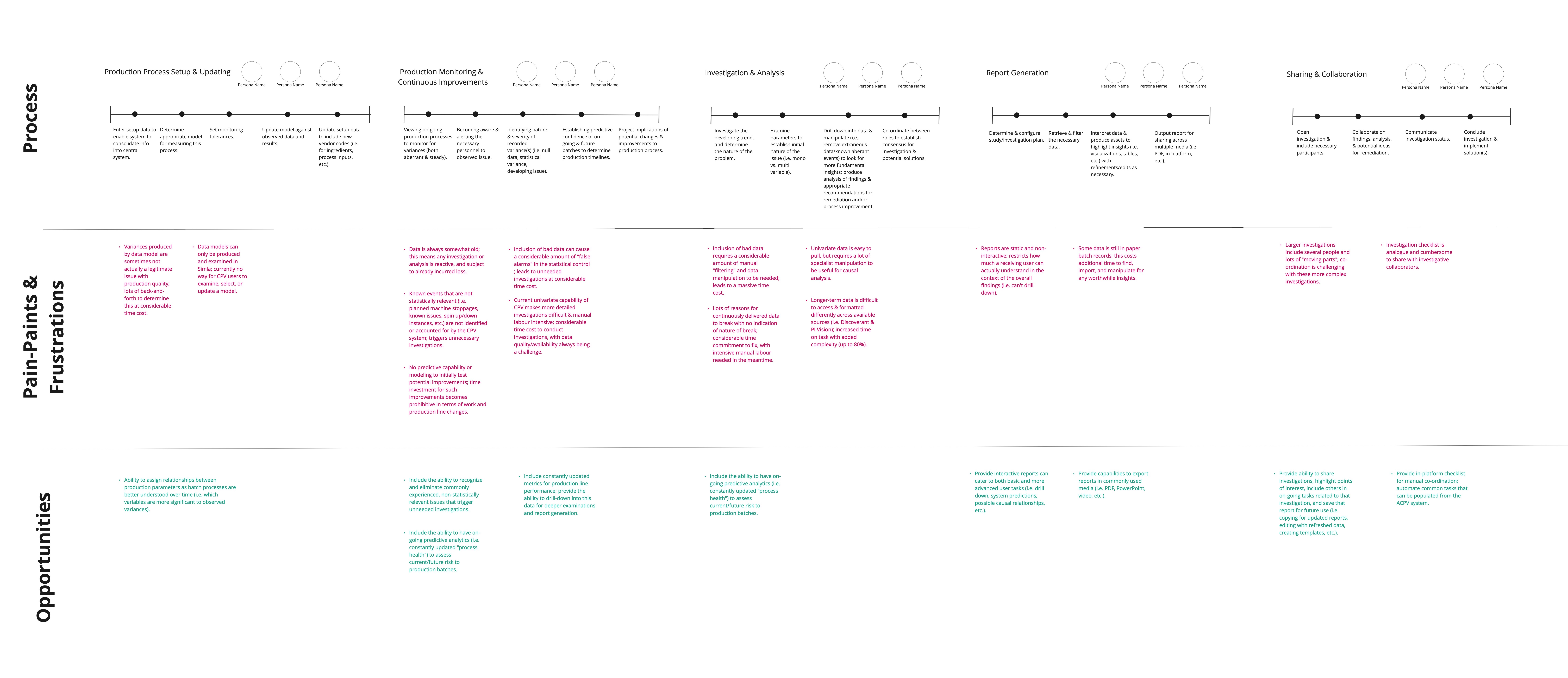 Identifying Opportunities for A.I. & Machine-Learning through Experience Mapping - For more complex projects that included multiple user-roles and touch-points, broader Experience Maps were used to highlight the strengths, weaknesses, and potential opportunities within a problem space. This would help us to identify opportunities for value, and prioritize them according to the severity of user needs.
Identifying Opportunities for A.I. & Machine-Learning through Experience Mapping - For more complex projects that included multiple user-roles and touch-points, broader Experience Maps were used to highlight the strengths, weaknesses, and potential opportunities within a problem space. This would help us to identify opportunities for value, and prioritize them according to the severity of user needs.
 Understanding & Prioritizing Requirements Collaboratively with User-Story Mapping - To understand and account for precise requirements in a complex project, detailed Story Maps were collaboratively created through UX facilitation with the broader product team; this created clear priorities for design and development, and fostered a clear release schedule, greater co-ordination, and interdisciplinary accountability.
Understanding & Prioritizing Requirements Collaboratively with User-Story Mapping - To understand and account for precise requirements in a complex project, detailed Story Maps were collaboratively created through UX facilitation with the broader product team; this created clear priorities for design and development, and fostered a clear release schedule, greater co-ordination, and interdisciplinary accountability.
Design & Team Leadership:
What We Learned (Insights & Actions Taken):
- Early Collaboration was Key to avoiding confusion between dispersed teams and complex technical requirements.
- Design Education for Context was needed to make effective collaboration possible.
- A.I. & Machine-Learning Technologies were a driving force that needed to be leveraged conscientiously to simplify industry complexity.
Value Generated (KPIs):
- Increased User Trust & Efficiency through smoother workflows and clear interactions that empowered users to accomplish more in less time.
- Increased Marketshare & Revenue provided by market-leading solutions delivered according to prioritized user-needs.
- Greater Resource Coordination & Efficiency for product delivery through validated and precisely targeted requirements that reduced/eliminated rework.
 Increasing Cross-Functional Capability through UX Education, Advocacy, & Governance - As demand for the UX Team's involvement grew, I was tasked with finding effective ways of delivering value to many different projects at different points of progress. Advocacy and education regarding the UX process, and how it could contribute value, was critical to building the context and awareness needed for that cross-functional collaboration.
Increasing Cross-Functional Capability through UX Education, Advocacy, & Governance - As demand for the UX Team's involvement grew, I was tasked with finding effective ways of delivering value to many different projects at different points of progress. Advocacy and education regarding the UX process, and how it could contribute value, was critical to building the context and awareness needed for that cross-functional collaboration.
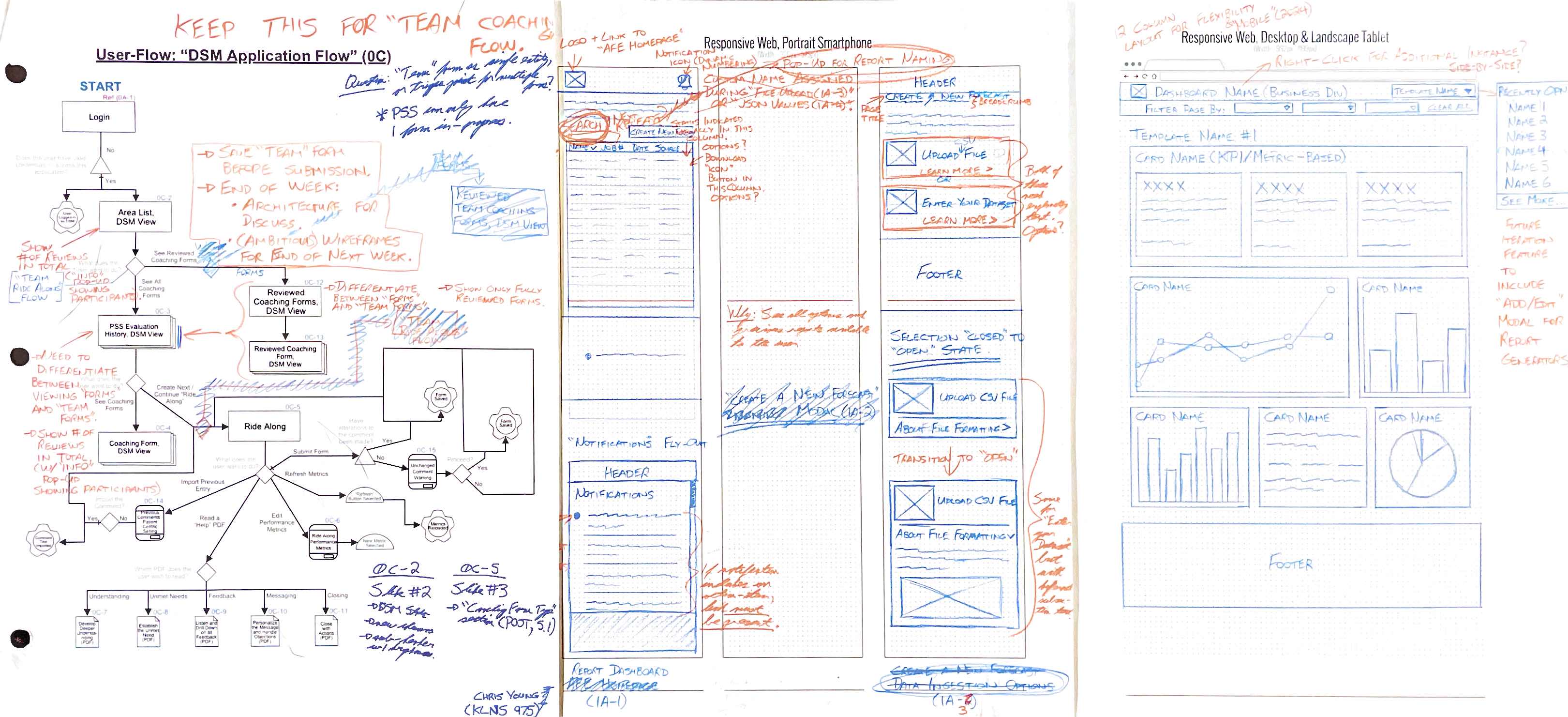 Efficient Product Design through User-Flows & Concept Sketches - These assets provided fast, inexpensive, and easily-testable concepts for the team’s initial review, and allowed for the rapid refinement of requirements through team input and feedback; this provided initial "stress testing" of a product in a few days, with validated concepts then pushed into rapid prototyping and development.
Efficient Product Design through User-Flows & Concept Sketches - These assets provided fast, inexpensive, and easily-testable concepts for the team’s initial review, and allowed for the rapid refinement of requirements through team input and feedback; this provided initial "stress testing" of a product in a few days, with validated concepts then pushed into rapid prototyping and development.
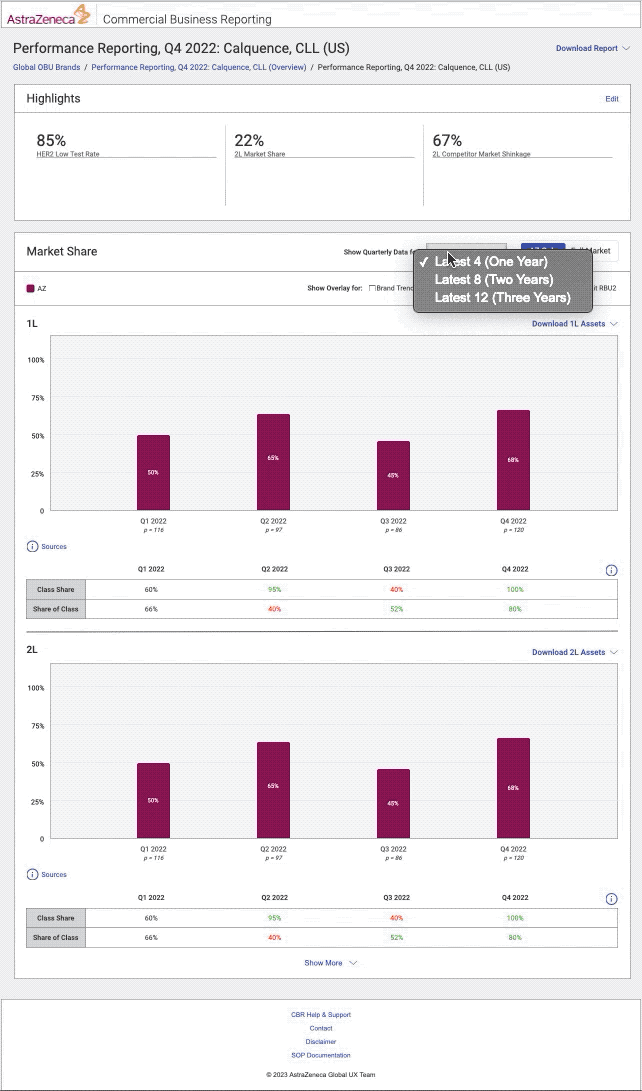 User & Stakeholder Engagement via High-Fidelity Prototypes - To ensure that users were getting the best experience possible, and that stakeholders were sharing in that experience, high-fidelity prototypes were exhaustively demonstrated, tested, and refined with those audiences. This provided invaluable feedback from our users, and generated excitement and confidence from our stakeholders.
User & Stakeholder Engagement via High-Fidelity Prototypes - To ensure that users were getting the best experience possible, and that stakeholders were sharing in that experience, high-fidelity prototypes were exhaustively demonstrated, tested, and refined with those audiences. This provided invaluable feedback from our users, and generated excitement and confidence from our stakeholders.
 Team Collaboration & Development Hand-Off via Product Mockups - After initial concept sketches were pressure tested and quickly refined, high-fidelity mockups were created; these could be used directly for development work, or further developed into prototypes for additional usability-testing.
Team Collaboration & Development Hand-Off via Product Mockups - After initial concept sketches were pressure tested and quickly refined, high-fidelity mockups were created; these could be used directly for development work, or further developed into prototypes for additional usability-testing.
Testing & Optimization:
What We Learned (Insights & Actions Taken):
- Clear Indicators for Success were needed by stakeholders to justify investment.
- More Product-Owner Engagement was needed to demonstrate value and build trust to increase design maturity.
- Product Success was based on Inconsistent Indicators that typically had nothing to do with user success through value provided.
Value Generated (KPIs):
- Increased User-Satisfaction through increased product value, usability, and learnability.
- Greater Revenue & Reduced Costs through more streamlined products that were easier to use, while utilizing product team resources more efficiently.
- Increased Usage & Market Adoption through the delivery of clearly prioritized requirements in a rapidly iterative environment.
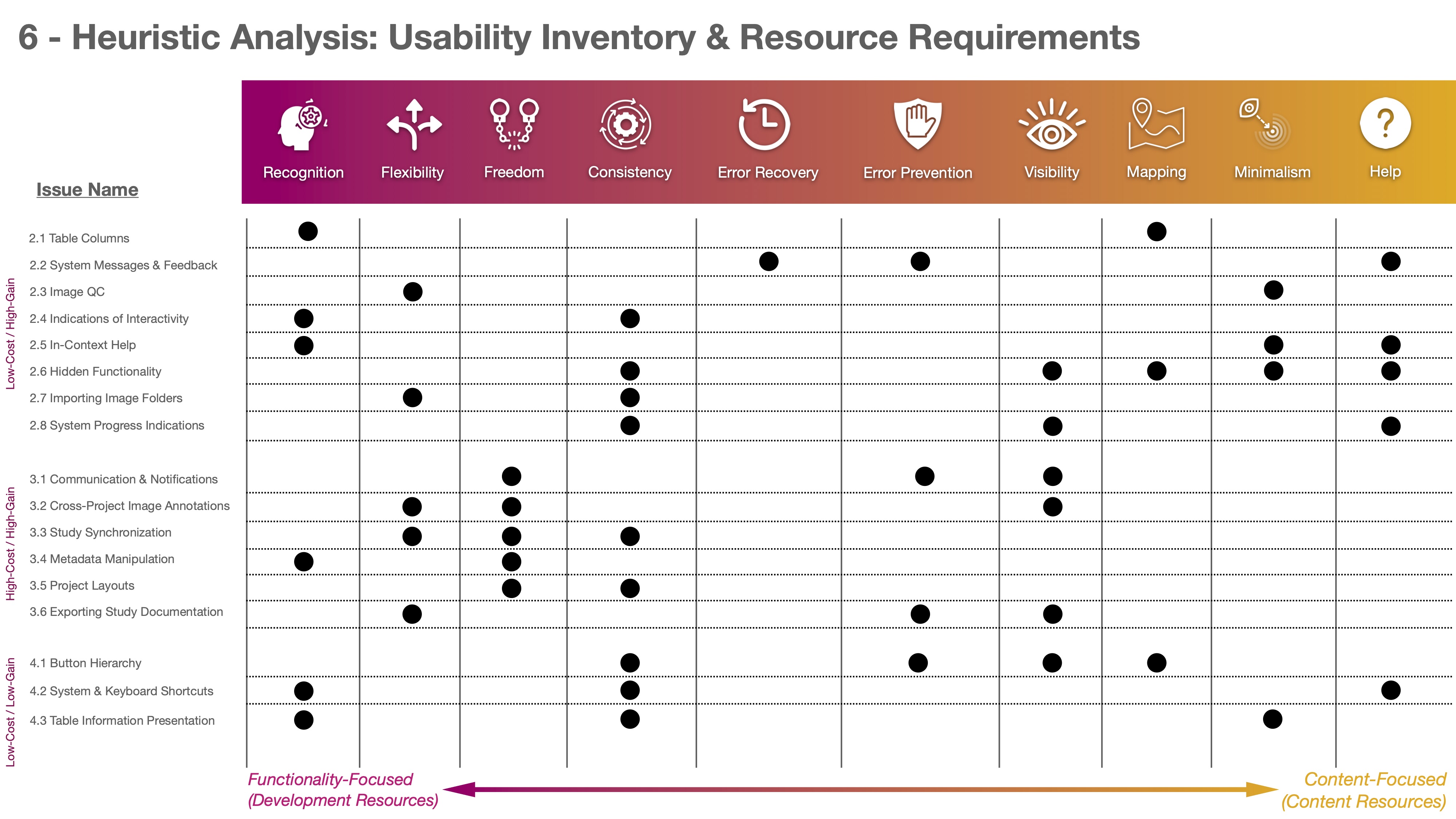 Product Optimization through Neilson Norman Usability Reviews - For existing products that suffered from limited adoption and engagement, a detailed Heuristic Analysis was used to prioritize efforts and determine the resources they would require. This allowed us to streamline existing value, while discovering gaps that could be filled to create a more compelling solution.
Product Optimization through Neilson Norman Usability Reviews - For existing products that suffered from limited adoption and engagement, a detailed Heuristic Analysis was used to prioritize efforts and determine the resources they would require. This allowed us to streamline existing value, while discovering gaps that could be filled to create a more compelling solution.
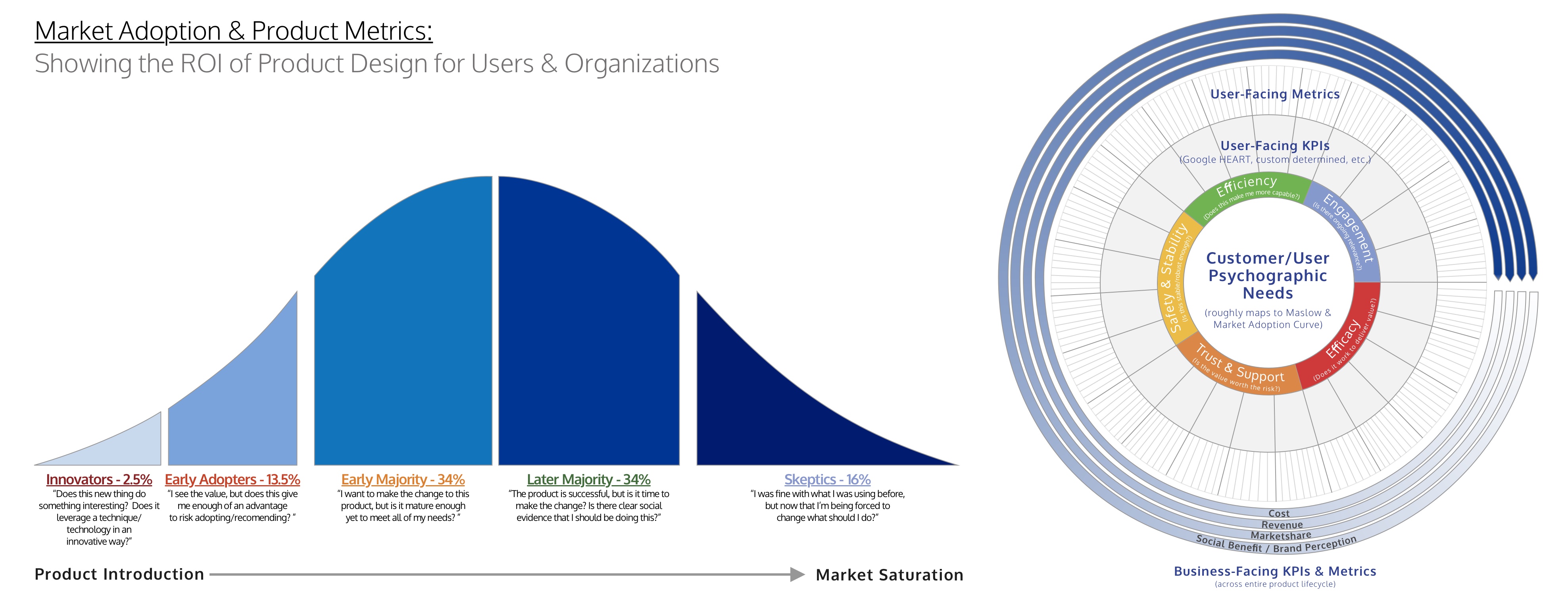 Tracking Progress through Meaningful Metrics - To track progress for solutions released to the market, I developed a framework of meaningful metrics that directly ties into user motivations. This allowed us to maintain a system of metrics that progressively tracked our success with each segment of users within the overall market, account for their different motivations, and compare those results against the overall benefit for the organization (i.e. revenue, costs, marketshare, etc.).
Tracking Progress through Meaningful Metrics - To track progress for solutions released to the market, I developed a framework of meaningful metrics that directly ties into user motivations. This allowed us to maintain a system of metrics that progressively tracked our success with each segment of users within the overall market, account for their different motivations, and compare those results against the overall benefit for the organization (i.e. revenue, costs, marketshare, etc.).
 Design Validation & Refinement via Usability-Testing - In addition to learning how users would receive our solutions, this allowed us to clearly demonstrate how a solution would work, encouraging stakeholder confidence.
Design Validation & Refinement via Usability-Testing - In addition to learning how users would receive our solutions, this allowed us to clearly demonstrate how a solution would work, encouraging stakeholder confidence.